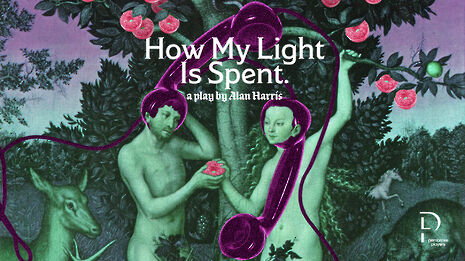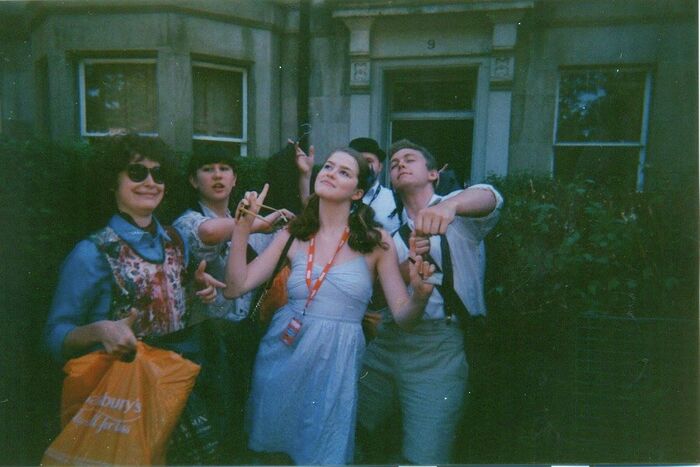How my light is spent review
This dark show is funny and touching, as well as being extremely well acted

From the first eye contact between Kitty (Anna Wright) and Jimmy (Harry Redding) there was a burst of electricity across the room. The connection between these two characters, and the actors, was evident from the first moment and that was the really special element about this play. These performances convincingly aided the unconventional story being told.
Jimmy is a worker at the one drive-through doughnut shop in Newport, and Kitty is the phone sex operator he calls once a week, and with whom he soon forms a relationship. The story develops as their lives begin to change: Jimmy thinks he is physically disappearing and is forced to nurture some neglected relationships, while Kitty is offered a more lucrative job offer poses a moral issue.
The forming of a relationship between a sex worker and someone who is having a mental breakdown is not easy to portray so convincingly. It should be noted that the script is somewhat problematic in its dealings with both sex workers and mental health. Its look at a sex worker, while morally ambiguous, didn't give us enough on why such a difficult decision was reached. As for mental health, while it is clear that the disappearance of Jimmy's hands is taking place inside his head, the uncertainties left to the audience are not unhelpful. However, in spite of these shortcomings, the characters were performed with great depth and dimension.
"Yet most amazingly the supporting characters all had a great amount of depth and development."
The same actors took on a handful of other roles in addition to those of Kitty and Jimmy, skilfully transforming themselves into a range of characters not only with a new prop (a mug or some glasses), but using posture and accent. The presence of these figures added humour, and diversified what was on stage. Yet most amazingly, the supporting characters all had a great amount of depth and development. It was easy to distinguish between characters, and I felt a range of different emotions for these characters. Despite a few line fluffs (which the actors recovered from gracefully) and a sometimes shakey Welsh accent, this was an all-round wonderfully acted piece.
Aaron Kilercioglu's direction should also be given some credit. As with many shows at the Fringe, the production likely faced many problems with the given venue, mainly because it is so small. This was overcome by extending the reach of the stage, having characters come into the middle of the aisle to make the audience more immersed. Given the small space, a lot of effort was put into keeping the scenes different and interesting. Slow, emotional scenes were followed by a fast-paced robbery sequence, with the audience plunged into darkness with only torches as lighting.
"The show is dark, bizarre, a bit filthy and truly touching."
Despite the changing of styles, the overall theme of the play, as one which looks into loneliness and finding comfort in unusual places, was maintained throughout. However, one flaw with the staging should be noted. A number of scenes were on the floor, which would be fine in a larger venue with tiered seating. This was not the case for this theatre, and the scenes should have been adapted for proper viewing for people beyond the front row.
The set also greatly enhanced the performance. A few very simple but effective pieces of scenery were used. Integral to the play were the phones positioned centre stage, used throughout by the two main characters. Not only was this practical, but the black line created by the standing phones served to delineate which side of the stage each actor mainly stuck to. In addition to the phones were two white blocks, serving for a number of purposes that included for humorous effect, most notably to portray a seesaw. These simple pieces of scenery, while obviously determined by the limitations of the Fringe, were really effective in their use.
The lighting should also be mentioned. While given the title of the show it must have been tempting to continuously fade the lighting, this effect was only used sparingly. This meant that when it was used (mainly with coloured gels in the lights), it made much more of an impact on the scene. The restraint should be congratulated.
How my light is spent delivers serious issues that we are used to discussing in a less than usual way. A script which is slightly lacking was made up for by talented performers and a capable director. The highlight of this show is truly the connection between the two actors, a well-developed performance if ever I saw one. The show is dark, bizarre, a bit filthy and truly touching. Make time to see a show that is out of the ordinary.
 News / Uni Scout and Guide Club affirms trans inclusion 12 December 2025
News / Uni Scout and Guide Club affirms trans inclusion 12 December 2025 News / Cambridge study finds students learn better with notes than AI13 December 2025
News / Cambridge study finds students learn better with notes than AI13 December 2025 News / Cambridge Vet School gets lifeline year to stay accredited28 November 2025
News / Cambridge Vet School gets lifeline year to stay accredited28 November 2025 Science / Did your ex trip on King’s Parade? The science behind the ‘ick’12 December 2025
Science / Did your ex trip on King’s Parade? The science behind the ‘ick’12 December 2025 News / Pembroke to convert listed office building into accom9 December 2025
News / Pembroke to convert listed office building into accom9 December 2025









